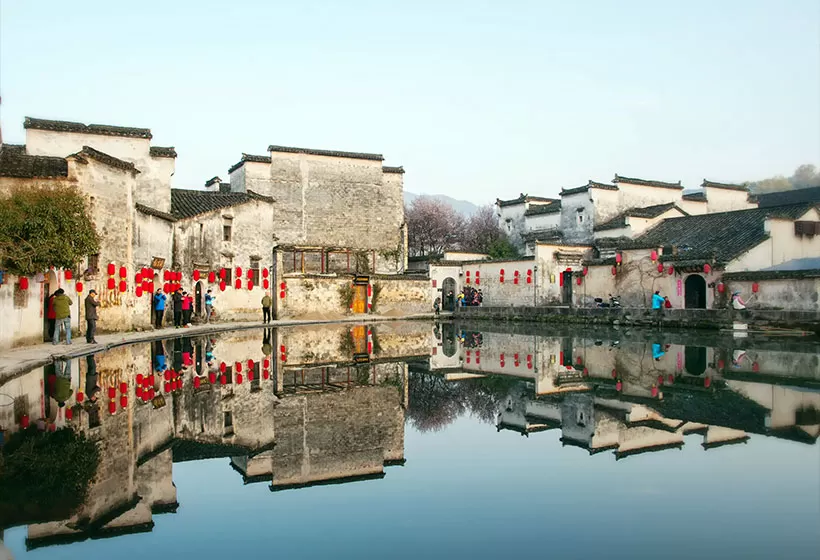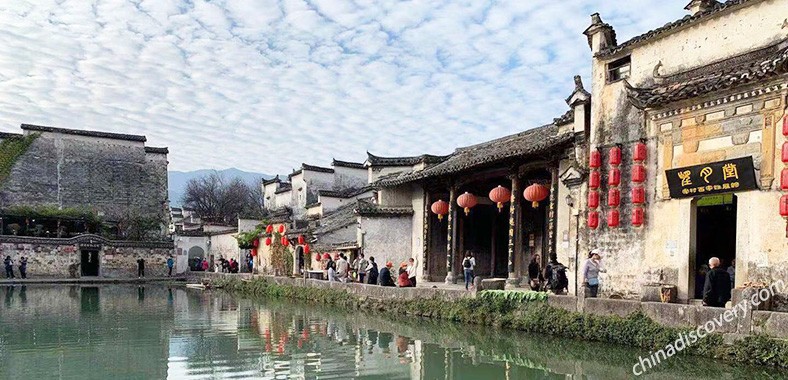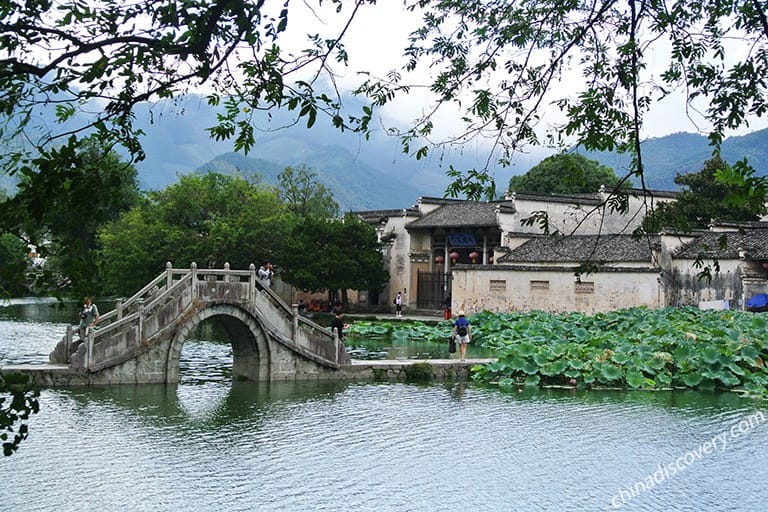Explore the Timeless Charm of Southern Anhui’s Ancient Villages: Xidi and Hongcun

An Essential Guide to Visiting Ancient Villages In Southern Anhui Xidi Hongcun
Nestled in the picturesque landscape of Southern Anhui, the ancient villages of Xidi and Hongcun beckon travelers with their timeless charm and rich cultural heritage. Recognized as UNESCO World Heritage Sites, these traditional villages offer a rare glimpse into the architectural brilliance and social structures of bygone eras. As you wander through the narrow, winding alleyways, flanked by well-preserved Ming and Qing dynasty buildings, you’ll feel as though you’ve stepped back in time.
Xidi, with its tranquil streams and harmonious integration of water systems, reflects the quintessential essence of Anhui architecture. The village is a tapestry of elegant gables adorned with intricate carvings—each telling a story of the prosperous merchants and officials who once called it home. Meanwhile, Hongcun captivates with its unique crescent-shaped layout, where the enchanting Moon Pond mirrors the sky, creating a serene ambiance that invites contemplation.
Both villages are not just a feast for the eyes; they are living museums that encapsulate the philosophies of Confucianism and Neo-Confucianism, evident in the respectful community dynamics and the tranquil lifestyle of the inhabitants. Here, you can savor local delicacies, engage with traditional customs, and immerse yourself in the vibrant culture that has thrived for over 600 years.
Whether you’re an avid history enthusiast or simply seeking a peaceful escape from the hustle and bustle of modern life, Xidi and Hongcun promise an unforgettable experience. Prepare to explore these ancient settlements, where every corner reveals a piece of history, and every encounter deepens your appreciation for the beauty of traditional Chinese culture.
In This Guide
- An Essential Guide to Visiting Ancient Villages In Southern Anhui Xidi Hongcun
- The Rich History and Legends of Ancient Villages In Southern Anhui Xidi Hongcun
- Main Highlights: What You Absolutely Can’t Miss
- Planning Your Visit: A Practical Guide
- Tickets: Prices, Booking, and Tips
- How to Get There: A Complete Transportation Guide
- Local Cuisine and Accommodation Nearby
- Frequently Asked Questions
- Final Thoughts on Your Trip
The Rich History and Legends of Ancient Villages In Southern Anhui Xidi Hongcun
Nestled in the picturesque landscape of Yi County, Huangshan City, the ancient villages of Xidi and Hongcun are more than just a feast for the eyes; they are living museums that encapsulate over six centuries of history, culture, and tradition. These two remarkable villages, designated as UNESCO World Heritage Sites in 2000, offer an immersive journey into the heart of traditional Chinese rural life.
Xidi, originally known as Xichuan or “West River,” thrives along the banks of three streams that flow harmoniously through its layout. This design reflects an intricate relationship with nature, a philosophy deeply rooted in Chinese culture that emphasizes harmony and balance. The village, founded during the Ming Dynasty, flourished as a center for trade and commerce, thanks in large part to the wealth generated by its returning officials and prosperous merchants. This affluence is evident in the exquisite architecture, where the traditional Anhui style marries functionality with artistry, characterized by delicate carvings and elegantly understated colors.
Hongcun, established in 1131 by General Wang Wen of the Han Dynasty, is similarly steeped in history. The village is famous for its unique layout, which resembles the shape of an ox—a symbol of prosperity and hard work in Chinese culture. The Moon Pond, located at the heart of Hongcun, is surrounded by residential buildings that reflect the village’s commitment to aesthetic beauty and ecological harmony. The ingenious water management system, completed in the 15th century, channels water from the nearby hills, providing not only a vital resource but also enhancing the village’s scenic charm.
The architectural features of both villages are integral to their historical significance. The buildings showcase the socio-economic structure of a bygone era, where clan-based social organization dictated daily life. Homes were often built in a manner that facilitated community bonds while also serving practical needs. Each household was typically adorned with intricate carvings that told stories of familial lineage and local legends, blending functionality with artistic expression.
Legends abound in these villages, enriching the tapestry of their history. One popular tale in Xidi speaks of a benevolent spirit that roams the streams, protecting the villagers and their harvests. This spirit is said to manifest as a gentle breeze that sweeps through the village, bringing good fortune. In Hongcun, it is believed that the Moon Pond is a sacred site where wishes made under the light of the full moon are granted, a tradition that endures among the locals and visitors alike.
The preservation of Xidi and Hongcun is not merely an act of safeguarding the past; it represents a commitment to maintaining the cultural heritage that has defined these villages for centuries. Both sites embody the principles of Confucianism, valuing respect for ancestors and the continuity of tradition. Today, they serve as vital resources for understanding regional history and culture, attracting scholars and travelers eager to learn about the rich narratives that shaped this part of China.
Visiting Xidi and Hongcun is akin to stepping back in time, where every alleyway and waterway tells a story of resilience, artistry, and community spirit. Here, the past is not a distant memory but a vibrant part of everyday life, waiting to be discovered by those who venture into these ancient villages.

Ancient Villages In Southern Anhui Xidi Hongcun.
Main Highlights: What You Absolutely Can’t Miss
Exploring the ancient villages of Xidi and Hongcun in Southern Anhui is like stepping back in time to witness the rich tapestry of Chinese culture and history. These two UNESCO World Heritage Sites are not only visually stunning but also offer a profound insight into traditional Chinese life. Here’s what you absolutely can’t miss during your visit:
1. Architectural Marvels
Both Xidi and Hongcun are renowned for their stunning architecture, which showcases the unique Anhui style. The whitewashed walls, black-tiled roofs, and intricately carved wooden beams reflect a harmonious blend of form and function. Don’t miss the opportunity to stroll through the narrow alleys, admiring the elegant gables and decorative stonework that date back centuries.
2. The Moon Pond in Hongcun
One of the iconic features of Hongcun is the picturesque Moon Pond, located at the village’s center. Its crescent shape and tranquil waters mirror the surrounding buildings, creating a serene and picturesque scene perfect for photography. Legend has it that the pond symbolizes harmony and unity, making it a must-see for those seeking a moment of peace.
3. The Water Systems
Both villages are ingeniously designed around comprehensive water systems, which are essential to their historical development. In Hongcun, take a moment to appreciate the ancient canals and streams that provided water for daily life and irrigation, illustrating the villagers’ deep connection to nature. The water systems not only served practical purposes but also added to the villages’ charm.
4. The Cultural Heritage
Immerse yourself in the rich cultural heritage of Xidi and Hongcun. Visit local galleries and museums that showcase traditional arts and crafts, such as ink painting, calligraphy, and paper cutting. Engage with the villagers, who are often eager to share stories about their customs and the significance of their heritage, embodying the spirit of the Confucian values that permeate the region.
5. The Huiyuan Bridge
In Xidi, the Huiyuan Bridge serves as a beautiful entry point to the village. This historic bridge, flanked by lush greenery, is not only a functional crossing but also a stunning example of the intricate stonework typical of the region. It’s a fantastic spot for capturing the essence of the village and its surrounding landscape.
6. Traditional Cuisine
A visit to Xidi and Hongcun wouldn’t be complete without tasting the local cuisine. Seek out traditional dishes such as bamboo shoots, stewed pork, and various rice-based delicacies. Several family-run restaurants offer authentic meals prepared with ingredients sourced from the surrounding countryside, ensuring a truly local dining experience.
7. Scenic Walking Trails
Surrounded by mountains and picturesque landscapes, both villages offer scenic walking trails that allow you to explore the natural beauty of the region. Take a leisurely hike to enjoy panoramic views of the villages against a backdrop of rolling hills and lush greenery. The tranquility of the rural setting enhances the charm of your experience.
8. Festivals and Events
If your visit coincides with a local festival, you’re in for a treat! Xidi and Hongcun host various cultural events throughout the year, celebrating traditional customs, music, and dance. These festivals offer a unique opportunity to witness the vibrant local culture and engage with the community.
9. Preservation Efforts
Lastly, take a moment to appreciate the ongoing preservation efforts that maintain the integrity of these ancient villages. Various initiatives are in place to protect the cultural and historical significance of Xidi and Hongcun, ensuring that future generations can enjoy their beauty and history.
Visiting Xidi and Hongcun is not just about seeing historic sites; it’s about experiencing the essence of traditional Chinese village life. Each corner of these villages tells a story, inviting you to pause, reflect, and immerse yourself in their rich cultural heritage.

Ancient Villages In Southern Anhui Xidi Hongcun.
Planning Your Visit: A Practical Guide
When planning your visit to the enchanting ancient villages of Xidi and Hongcun in Southern Anhui, there are several key aspects to consider to ensure an unforgettable experience. These villages, celebrated for their well-preserved architecture and rich cultural heritage, offer a glimpse into China’s historical past and traditional village life.
Getting There
Location: Xidi and Hongcun are located in Yi County, Huangshan City, Anhui Province, approximately 10 kilometers apart.
Transportation:
– By Air: The nearest airport is Huangshan Tunxi International Airport (TXN), which is about 55 kilometers from the villages. From the airport, you can hire a taxi or take a bus to Tunxi, and then transfer to a local bus heading to Xidi or Hongcun.
– By Train: The closest major train station is in Huangshan City. High-speed trains connect Huangshan with major cities like Shanghai and Hangzhou. From Huangshan Railway Station, local buses or taxis can take you to the villages.
– By Bus: Direct buses run frequently from Huangshan City to both Xidi and Hongcun. This is a convenient and affordable option for travelers.
Best Time to Visit
The ideal time to explore Xidi and Hongcun is during the spring (March to May) and autumn (September to November) months. The weather is generally mild, making it perfect for leisurely strolls through the villages. Additionally, the scenery is particularly beautiful during these seasons, with blooming flowers in spring and vibrant autumn foliage.
Exploring the Villages
What to See:
– Architectural Wonders: Marvel at the unique Anhui-style architecture characterized by whitewashed walls and black-tiled roofs. Be sure to visit the famous Moon Pond in Hongcun and the intricate carvings in the halls of both villages.
– Cultural Heritage: Engage with the local culture by visiting ancestral halls, traditional shops, and art galleries showcasing local crafts. Don’t miss the chance to sample regional delicacies at local eateries.
– Water Systems: Observe the ingenious water supply systems that have been in place for centuries, adding to the charm and historical significance of the villages.
Recommended Itinerary:
1. Morning: Arrive early to Xidi, explore its narrow lanes, and visit the notable sites such as the Xidi Ancient Street and the Hu Wenguang Memorial Hall.
2. Lunch: Savor a traditional meal at a local restaurant, featuring Anhui cuisine.
3. Afternoon: Head to Hongcun, where you can take a leisurely walk around the Moon Pond and explore the Wang Family Ancestral Hall.
4. Evening: Stay for sunset to witness the picturesque views of the villages reflected in the waters.
Practical Tips
- Accommodation: Consider staying overnight in local guesthouses or boutique hotels to fully experience village life. This also allows for early morning or late evening explorations when the villages are less crowded.
- Cash: While some establishments may accept credit cards, it’s advisable to carry cash (RMB) for small purchases.
- Language: English is not widely spoken, so having a translation app or a phrasebook can be helpful.
- Respect Local Customs: Be mindful of the local culture and traditions. Always ask for permission before taking photos of people or private properties.
Responsible Tourism
As these villages are UNESCO World Heritage Sites, it’s essential to practice responsible tourism. Respect the local environment, support local businesses, and follow guidelines set by the heritage management to help preserve these historical treasures for future generations.
By planning ahead and immersing yourself in the rich cultural tapestry of Xidi and Hongcun, you will undoubtedly create lasting memories of your visit to these ancient villages in Southern Anhui.

Ancient Villages In Southern Anhui Xidi Hongcun.
Tickets: Prices, Booking, and Tips
When planning your visit to the enchanting Ancient Villages of Southern Anhui, Xidi and Hongcun, it’s crucial to be informed about ticket prices, booking options, and helpful tips to enhance your experience.
Ticket Prices
As of late 2023, the entrance fee for each village is approximately CNY 104 (around USD 15), which grants you access to both Xidi and Hongcun, allowing you to explore their rich cultural heritage and stunning architecture. Note that prices can vary slightly during peak tourist seasons or festivals, so it’s advisable to check ahead.
Booking Tickets
Tickets can be conveniently purchased on-site at the entrance of each village. However, to avoid long queues, especially during weekends and holidays, consider booking in advance. Online platforms and travel agencies often offer tickets that include guided tours, providing insightful perspectives on the villages’ history and significance.
Tips for Visiting
-
Timing Your Visit: The best time to visit Xidi and Hongcun is during the spring (March to May) and autumn (September to November) when the weather is mild and the scenery is breathtaking. Early mornings or late afternoons are particularly magical, with soft lighting perfect for photography.
-
Guided Tours: If you want to delve deeper into the history and culture of these ancient villages, consider joining a guided tour. Knowledgeable guides can provide fascinating insights that enhance your understanding of the unique architectural styles and the stories behind the buildings.
-
Cultural Etiquette: As these villages are not just tourist attractions but also living communities, be respectful of local customs. Engage with residents politely, and always ask before photographing people or their homes.
-
Explore Beyond the Main Attractions: While the main streets and popular sites are undoubtedly captivating, take the time to wander through the quieter alleyways and lesser-known corners of Xidi and Hongcun. You’ll discover hidden gems, such as local crafts and unspoiled views.
-
Local Cuisine: Don’t miss the chance to savor local dishes in one of the village eateries. Traditional Anhui cuisine is renowned for its rich flavors and unique cooking methods. Be sure to try specialties like stewed bamboo shoots and Xidi dried tofu.
-
Cash is King: While more places are starting to accept credit cards, many small shops and food stalls only take cash, so it’s wise to have some Chinese yuan on hand.
By planning ahead and keeping these tips in mind, your visit to Xidi and Hongcun will be not only memorable but also full of enriching experiences amidst the backdrop of ancient Chinese culture. Enjoy your journey through these remarkable UNESCO World Heritage sites!
How to Get There: A Complete Transportation Guide
To reach the enchanting ancient villages of Xidi and Hongcun in Southern Anhui, travelers can choose from various transportation options depending on their starting point. These villages, celebrated for their well-preserved architecture and rich cultural heritage, are accessible via public transport, private vehicles, and guided tours. Here’s a comprehensive guide to help you navigate your journey to these UNESCO World Heritage sites.
Arriving by Air
The nearest major airport to Xidi and Hongcun is Huangshan Tunxi International Airport (TXN), located approximately 65 kilometers from the villages. This airport offers domestic flights from major cities such as Beijing, Shanghai, and Guangzhou.
- From Huangshan Airport to Xidi and Hongcun:
- Taxi: The most convenient way to reach the villages is by taxi, which takes around 1.5 hours. Ensure to negotiate the fare or request the driver to use the meter.
- Airport Shuttle: There are shuttle buses available that run to Tunxi, from where you can catch a bus or taxi to the villages.
Arriving by Train
For those already in China, traveling by train to Huangshan City (the nearest urban area) can be a scenic option:
- Huangshan North Railway Station: Trains connect this station with major cities, including Shanghai, Hangzhou, and Nanjing.
- From Huangshan North to Xidi and Hongcun:
- Bus: Regular buses run from Huangshan North Railway Station to Yi County, where both Xidi and Hongcun are located. This journey takes about 40-60 minutes.
- Taxi: Alternatively, taxis are available for a direct ride, taking about 30 minutes.
Arriving by Bus
If you’re based in nearby cities, local buses provide a good option:
- From Tunxi (Huangshan City):
- Direct Bus Service: Buses depart frequently from Tunxi Bus Station to Xidi and Hongcun. The trip takes around 1 hour, and tickets are inexpensive.
- Travel Tip: Make sure to check the bus schedules in advance, as they can vary depending on the season.
Self-Driving
For those who prefer to drive, renting a car can offer flexibility to explore the picturesque countryside:
- Driving Directions:
- From Huangshan City, take the G205 national road towards Yi County. Follow signs to Xidi and Hongcun, which are well-marked and approximately 65 kilometers away.
- Parking: Both villages have designated parking areas, but it’s advisable to arrive early during peak tourist seasons to secure a spot.
Guided Tours
If navigating local transportation isn’t your preference, consider booking a guided tour:
- Many travel agencies in major cities offer day trips to Xidi and Hongcun, including transportation, a guide, and sometimes meals. This option allows you to enjoy the sites without the hassle of planning your itinerary.
Final Thoughts
No matter which mode of transportation you choose, the journey to Xidi and Hongcun is well worth it. As you approach these ancient villages, prepare to be captivated by their stunning landscapes, intricate architecture, and the serenity of a bygone era. Make sure to bring your camera, as these picturesque settings offer countless opportunities for unforgettable photographs. Safe travels!

Ancient Villages In Southern Anhui Xidi Hongcun.
Local Cuisine and Accommodation Nearby
Exploring the ancient villages of Xidi and Hongcun is not just a journey through history, but also an opportunity to indulge in a rich tapestry of local flavors and comfortable stays. Nestled in the picturesque landscapes of southern Anhui, these villages offer visitors a chance to savor authentic Huizhou cuisine and experience traditional hospitality.
Local Cuisine
When it comes to food, the Huizhou region is renowned for its rich culinary traditions that reflect the area’s agricultural heritage. Here are a few must-try dishes:
-
Braised Bamboo Shoots (红烧竹笋): This delicacy showcases the region’s fresh bamboo shoots, expertly braised with soy sauce and spices, offering a delightful crunch and savory taste.
-
Stir-Fried River Shrimp (清炒小龙虾): Freshly caught from the nearby rivers, these shrimp are lightly stir-fried with garlic and ginger, preserving their natural sweetness.
-
Huizhou Tofu (徽州豆腐): Known for its unique texture, this tofu is often served in various forms, from hot pots to cold dishes, and is a staple in local households.
-
Steamed Pork with Salted Fish (咸鱼蒸肉): A comforting dish featuring layers of marinated pork and salted fish, steamed to perfection, allowing the flavors to meld beautifully.
-
Eight-Treasure Rice Pudding (八宝饭): For dessert, indulge in this sweet treat made with glutinous rice, filled with an array of colorful ingredients like red beans, dates, and nuts, symbolizing prosperity and good fortune.
Local eateries can be found throughout Xidi and Hongcun, many of which are family-run establishments. The warm hospitality of the locals adds to the dining experience, making every meal here a memorable one.
Accommodation Nearby
To fully immerse yourself in the charm of these ancient villages, consider staying at one of the local accommodations that offer a glimpse into traditional Huizhou architecture and modern comforts:
-
Xidi Ancient Village Hotel: Located right in the heart of Xidi, this hotel blends traditional aesthetics with contemporary amenities. Guests can enjoy stunning views of the surrounding mountains and streams while relishing the tranquility of village life.
-
Hongcun Inn: Situated near the famous Moon Pond, this charming inn features beautifully decorated rooms that reflect the local architectural style. The innkeeper often shares stories about the village’s history, enhancing your experience.
-
Huangshan Hotel: A short distance from both villages, this hotel offers comfortable rooms and a restaurant that specializes in local cuisine. It’s an excellent base for exploring the area while enjoying modern conveniences.
-
Boutique Guesthouses: For a more intimate experience, consider one of the boutique guesthouses that dot the villages. Many of these offer personalized service, home-cooked meals, and a chance to connect with local culture.
Each accommodation option provides a unique perspective on life in these historic villages, making your stay not just a visit but a deeper connection to the heritage of southern Anhui. Whether you’re savoring the local dishes or resting in a quaint guesthouse, Xidi and Hongcun promise an enchanting escape into China’s past.

Ancient Villages In Southern Anhui Xidi Hongcun.
Frequently Asked Questions
Frequently Asked Questions
1. What is the best time to visit Xidi and Hongcun?
The ideal time to explore Xidi and Hongcun is during the spring (April to June) and autumn (September to November) months. During these seasons, the weather is generally mild, and the landscapes are particularly beautiful, with blooming flowers or vibrant autumn foliage enhancing the villages’ charm.
2. How do I get to Xidi and Hongcun from Huangshan City?
Travelers can reach Xidi and Hongcun by taking a bus from Huangshan City, which typically takes around 1 to 1.5 hours. Alternatively, you can hire a taxi or join a guided tour that includes transportation. Ensure you check local schedules for the latest bus timings.
3. Are there entrance fees for visiting the villages?
Yes, there is an entrance fee for both Xidi and Hongcun. The fees can vary, so it’s advisable to check at the ticket booth or visit the official tourism websites for updated prices. Discounts may be available for students and seniors.
4. What should I wear while visiting the villages?
Comfortable walking shoes are highly recommended, as you’ll be exploring cobblestone paths and narrow alleys. Dress in layers, as temperatures can fluctuate throughout the day, especially in spring and autumn. Also, don’t forget to bring a hat and sunscreen for sun protection.
5. Can I find accommodation in or near Xidi and Hongcun?
Yes, both villages offer a range of accommodation options, from traditional guesthouses to boutique hotels. Staying in one of the local inns can enhance your experience, allowing you to soak in the village atmosphere. It’s advisable to book in advance, especially during peak tourist seasons.
6. What activities can I enjoy in Xidi and Hongcun?
Visitors can explore the stunning traditional architecture, including ancient houses, ancestral halls, and beautiful gardens. You can also enjoy boat rides on the waterways, participate in local workshops (like calligraphy or painting), and indulge in authentic Anhui cuisine at local restaurants.
7. Are there any local customs or etiquette I should be aware of?
While visiting, it’s important to respect the local culture. Greet locals politely, try to speak a few words of Mandarin if possible, and avoid loud conversations, especially in sacred areas. When taking photographs, always ask for permission if locals are included in your shots.
8. Is it possible to explore Xidi and Hongcun on foot?
Absolutely! Both villages are quite compact and best explored on foot. This allows you to take in the scenery at your own pace, wander through narrow alleys, and discover hidden gems that might be missed when traveling by vehicle. Just be prepared for some uneven terrain in certain areas.
Final Thoughts on Your Trip
As you conclude your journey through the enchanting ancient villages of Xidi and Hongcun, take a moment to reflect on the rich tapestry of history, culture, and architecture that these remarkable sites embody. Every narrow alleyway and waterway tells a story of a bygone era, where commerce and community flourished in harmony with nature. The intricate carvings on the gables, the serenity of the Moon Pond, and the rhythmic flow of the streams all invite you to pause and appreciate the artistry of traditional Chinese craftsmanship.
Visiting Xidi and Hongcun is not merely an exploration of age-old buildings; it’s an immersion into a way of life that has been carefully preserved for over six centuries. These villages stand as testaments to resilience, showcasing the values and traditions that have shaped the identity of Anhui Province. As you leave, carry with you the spirit of these ancient settlements—the sense of unity, respect for nature, and the importance of community.
Whether you are a history enthusiast, a lover of architecture, or simply seeking a tranquil escape from modernity, Xidi and Hongcun offer a unique glimpse into China’s cultural heritage. Let the memories of your visit inspire you to delve deeper into the stories of the past and appreciate the beauty of preserving our shared history for future generations. Safe travels, and may your adventures continue to be filled with wonder and discovery!